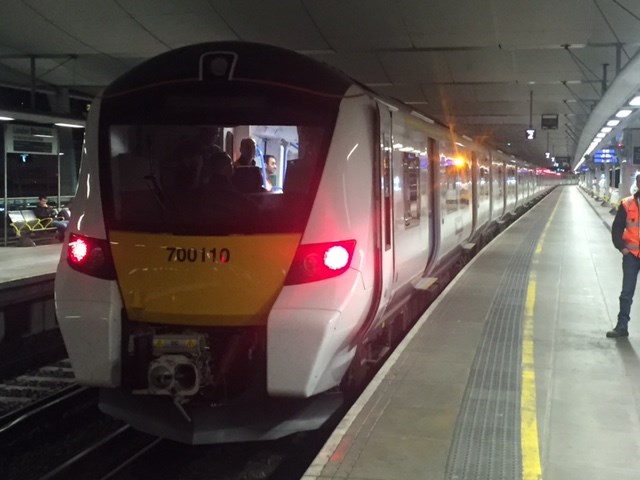Wednesday 3 Aug 2016
The Thameslink Programme successfully tests new trains using advanced “in-cab” signalling system
- Region & Route:
- | Southern
An advanced signalling system that will allow trains to travel every two to three minutes through central London was successfully tested using Govia Thameslink Railway’s new Siemens Class 700 trains for the first time.
The Thameslink Programme, part of Network Rail’s Railway Upgrade Plan to provide a bigger, better, more reliable railway for passengers and businesses, achieved another milestone in the early hours of Saturday morning as it successfully ran a Class 700 train through the central London “core” using European Train Control System (ETCS) Level 2 in-cab signalling.
In-cab signalling is required to allow trains to be driven automatically between St Pancras and Blackfriars stations, under driver supervision, in order to enable up to 24 trains to operate per hour from 2018. This was the first in a series of functional and operational tests planned over the next sixteen months to ensure that trains operate safely and efficiently.
Last year, Network Rail tested its in-cab infrastructure through central London using a Class 313 test train and in collaboration with Govia Thameslink Railway (GTR) and Siemens, tests have been run using a Class 700 train at the ETCS National Integration Facility. This weekend was, however, the first time that a Class 700 train has been tested in central London using the infrastructure it will run on in passenger service from 2018, providing more frequent, more reliable journeys for passengers.
Paul Bates, project director for Network Rail, said: “This is a significant milestone towards enabling the frequency of service that will keep London moving and provide better journeys through the heart of the capital. This success is a testament to the integrated and collaborative approach taken by GTR, Siemens and Network Rail, to achieve collective success.”
John Killeen, Head of Fleet Programmes for GTR, said: “Ultimately, ETCS will allow us to run our trains under automatic train operation at high frequencies through central London. This, in turn will create the capacity to run extra Thameslink trains to and from Peterborough and Cambridge, giving passengers fantastic new journey opportunities.”
Mark Ferrer, New Technology Director at Siemens Rail Automation, said: “The success of these trials reflects directly on the extremely close and effective collaboration between Network Rail, Siemens and GTR. The delivery of this ground-breaking system is also a clear demonstration of our ability to deliver the future digital railway, which will increasingly require the definition, development and delivery of these complex systems as the digital railway becomes ever more prevalent.”
Dave Hooper, Thameslink Programme Director, Siemens Rail Systems, said: “This is another key milestone achieved for the Thameslink Programme. Close collaboration between Siemens, Network Rail and GTR has been an essential ingredient to this success, as has the robust planning and preparation that helps make these achievements look simple, when in fact this is ground-breaking progress for ATO and ETCS service introduction in the UK. We are looking forward to delivering the rest of the programme successfully in the same professional manner with our industry partners.”
Overnight testing will continue in September, with the first trials of the Automatic Train Operation (ATO) system between St Pancras and Blackfriars. ATO, which enables the train to operate automatically through the “core”, was tested successfully at the ETCS National Integration Facility test site on the Hertford loop earlier this year.
The Thameslink Programme is due to take another step forward over the August bank holiday when two thirds of the new concourse is planned to reopen at London Bridge station, resulting in significant service changes for passengers. Passengers should check before they travel.
Contact information
Passengers / community members
Network Rail national helpline
03457 11 41 41
Latest travel advice
Please visit National Rail Enquiries
Journalists
Network Rail press office - Alexandra Swann
07734 650735
Alexandra.Swann@networkrail.co.uk
About Network Rail
We own, operate and develop Britain's railway infrastructure; that's 20,000 miles of track, 30,000 bridges, tunnels and viaducts and the thousands of signals, level crossings and stations. We run 20 of the UK's largest stations while all the others, over 2,500, are run by the country's train operating companies.
Usually, there are almost five million journeys made in the UK and over 600 freight trains run on the network. People depend on Britain's railway for their daily commute, to visit friends and loved ones and to get them home safe every day. Our role is to deliver a safe and reliable railway, so we carefully manage and deliver thousands of projects every year that form part of the multi-billion pound Railway Upgrade Plan, to grow and expand the nation's railway network to respond to the tremendous growth and demand the railway has experienced - a doubling of passenger journeys over the past 20 years.
Follow us on Twitter: @networkrail
Visit our online newsroom: www.networkrailmediacentre.co.uk

